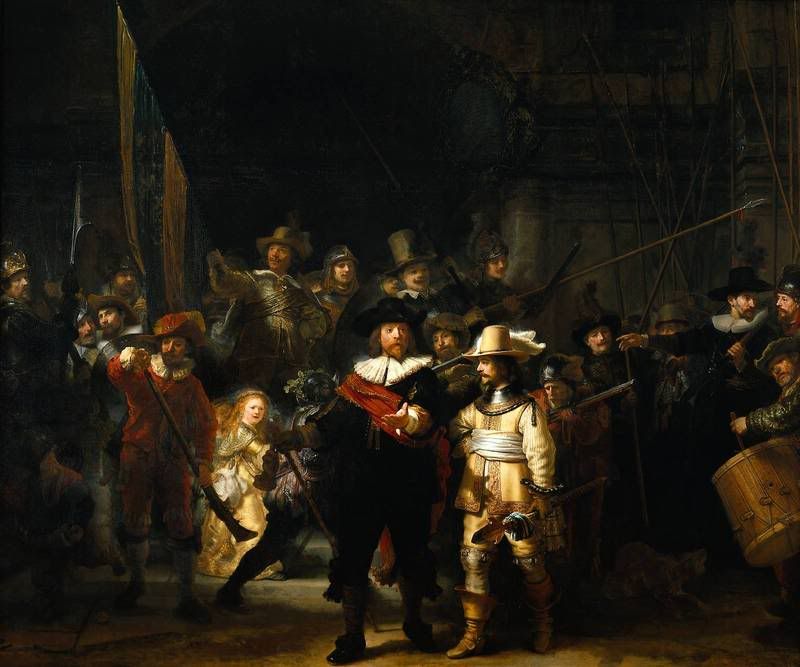
Rembrandt Harmenszoon van Rijn "Night Watch", 1642
In the article "Rembrandt and the Nightwatch" at History of Holland.com there is an uncredited quote poetically describing Rembrandt's state of mind following the death of his wife Saskia. It states, "-he seemed like a man on a mountain top, looking on one side to sweet meadows filled with flowers and sunlight, and on the other to a desolate landscape over which a clouded sun is setting".
Saskia died in 1642, the same year Rembrandt was commissioned to paint what is arguably the most famous of his many paintings, drawings and prints, "The Company of Frans Banning Cocq and Willem van Ruytenburch", also known as "The Sortie" or, most commonly, "Night Watch". Rembrandt is one of those historical figures whose great talent brought him lifelong success and recognition, but whose life was filled with financial hardships and familial tragedy. The duality of his experience is manifest in his layered, complex, sensitive works, examinations of the light in contrast to the dark.
Rembrandt was a product of what is termed the Dutch Golden Age, coincident in the arts with the Baroque movement. The Baroque was a cultural revolution, a movement away from the artificial conventions of Mannerism, towards increased Naturalism and, most important for the purpose of this article, an increased expression of emotionality and drama. The popular name of Rembrandt's masterpiece, "Night Watch", is a misnomer originally applied by the British painter Sir Joshua Reynolds, first president of the Royal Academy. A dark coat of varnish made the group portrait appear to be a night scene, when in fact the image is set in full, natural light. Reynolds himself was a polarizing figure, as he and the Academy represented a mid 19th century return to Mannerism, which led to the counter-revolution of the Pre-Raphaelites.
Breaking a highly complex process down into very simplistic terms, this action of revolution and counter-revolution between intellectual "classicism" and emotional "romanticism" is an interplay observable throughout the span of art history, which is in no way separate from the span of cultural history. It is a pendulum swing, back and forth, a natural, rhythmic cycle, but one that expresses itself as a conflicting dichotomy.
It would be negligent to discuss Rembrandt's "Night Watch" without commenting on the radiant figure of the little girl moving through the company of the militia. Though it is difficult to see in reproductions, she carries the company's chalice, a clear indicator, if any more were needed, of her importance and identity. Though a child, she bears a remarkable resemblance to Rembrandt's wife Saskia, as said, recently deceased at the time when this work was executed, whom he frequently utilized as a model. At this point in time Rembrandt had also lost two daughters, though both were infants.
It is not unusual to see a grail-bearer depicted as a young girl, especially so in Northern European iconography. Further, there is a certain relation between the figure of a sovereignty goddess, and the embodiment of a group or company's charter or purpose in a female form. Naturally, these concepts are interrelated. The fact that Rembrandt would choose to personify this goddess figure as the illuminating spirit of personal loved ones emphasizes her level of allegorical importance. Almost as interesting, and subject of far less commentary, is the small, male, helmeted figure on the viewer's far left. I describe him in this vague way because while I've seen him described as a male child, to me he looks like he has the proportions of an Achondroplastic dwarf. Further, his face is, as far as I can discern, completely obscured by shadow. He almost looks like he may have popped into this panel from a Bosch or a Bruegel the Elder composition from one hundred years earlier. He seems to move about as invisible to the company as the radiant girl, moving away from her, into darkness. Into the gloom. Perhaps "Night Watch" is not such a misnomer after all. And while we're here lets be sure to take notice of the ornate mirror situated above a column.
When I first heard about the films "Night Watch" and "Day Watch" from -sky- , back when we were talking just a little about the Owls, I was immediately intrigued. A super natural, action-adventure battle between occult orders of lightness and darkness? From Russia? Cool. Very fascinating films, which I'm glad I took some time to view more then once and digest a bit before talking about them. The allusion to the Baroque is apt. "Night Watch" and "Day Watch" are essentially high romance, gothic operas (in the way that "Star Wars" is opera), as such suffused with esoteric symbolism and patterns. The story line is an allegory of Chiaroscuro, one of the defining characteristics of Baroque visual tradition. In this article I'll focus primarily on the film version of "Night Watch", with hopes of a future article mainly dealing with the sequel.
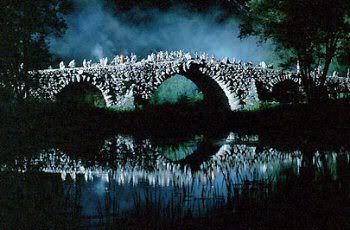
"Night Watch" and "Day Watch" tell the story of a supernatural subset of the human race, generally termed "Others", which includes witches and wizards, shape shifters, vampires, and apparently any manner of occult ability. A point is stressed that no two Others are alike. The super natural abilities seem to be primarily inborn, and also to be trainable, like a tradition or an art. We find this same essential pattern in the X-Men franchise and the Harry Potter series, all include very basic presentations of Invisible Colleges. Since we're pointing out similarities to other, more famous works, I'll note that the term "Night Watch" is synonymous to "Watchmen".
The Others are divided into two opposing camps, the Light Others and the Dark Others, those who protect general humanity and those who prey upon them. This was the status quo for centuries, with the two forces so evenly matched neither was ever able to gain the upper hand. The film opens with armies representing the two sides, led by their leaders, Gesser for the Light and Zavulon for the Dark, meeting on a Bridge.
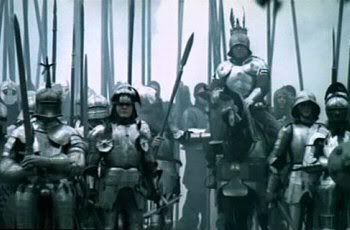
Gesser (mounted) and his Light Other soldiers
The battle to end all battles begins on that Bridge, but Gesser saw the two sides would completely obliterate one another. To ensure mutual survival of their people, Gesser and Zavulon struck a deal. A balance would be maintained. All Others from that point forward would be free to choose which side they would serve, no one could be forced. One day a Great Other, more powerful then all before, would come, and their decision would upset the balance and the Final Battle would ensue. In the interim, to keep both sides on the up and up, a neutral judging institution, the Inquisition, was established. Likewise both sides created bodies to police the activities of their enemies, the Night Watch, who monitor the Dark Others, and the Day Watch who do the counter.
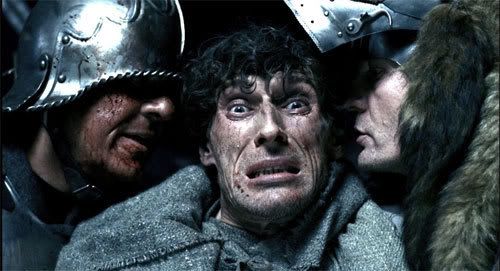
Gesser and Zavulon create the Inquisition
This to me is a very intriguing aspect of this plot line, the portrayal of the forces of good and evil locked in tense, bureaucratic, inter-policed stalemate, a cold war. That this bargain was struck upon a Bridge is fully appropriate. This complex symbolic item demands our attention lately. The Bridge is always about transitions, and transformations, the linking of this world to the next. A stalemate on a Bridge carries the clear connotation of a postponed inevitability. There are only two viable directions of movement available.
The story then jumps ahead to Moscow, 1992, where we see everyman Anton Gorodetskiy consult a witch in hopes of winning back his estranged wife. From the witch, Darya Schultz, Anton learned that his wife was pregnant with another man's child. Schultz implied she could easily return Anton's wife to him, but that the child would always pull her away again. Anton maintained skepticism throughout his conversation with Schultz, seeming embarrassed to be there. So when she suggested the child could be killed before it was ever born, so long as Anton was willing to take the sin of the action onto himself, he nonchalantly agreed.
I don't intend to discuss these films blow by blow, but this is a key moment to the story's devices. The witch, a Dark Other, broke the law by guiling Anton into sin. This caused immediate intervention by agents of the Night Watch. The Night Watch interrupted Schultz's spell. They entered through what is termed "the Gloom" or "Twilight". The Gloom is a metaphysical level of existence only accessible to Others. It is quite plainly the "Other World", the Oz/Wonderland/Dreamtime/Afterlife/et al., we find so frequently in these Baroque fantasies. In this case we find the locale directly tied to altered or higher states of consciousness. The Gloom is not so much another place as a deeper aspect of reality perceivable in heightened states of consciousness. Being able to achieve this state, being able to access the Twilight, automatically makes an individual an Other. The Gloom has a draining, and seemingly sentient quality. In the films, one of the indicators for viewers that characters have entered the Gloom is the sudden presence of mosquitoes, emphasizing the prevalent vampiric elements of the story.
While in the Gloom, the Night Watch agents are at first invisible to Anton. But Anton, perhaps because he was already inebriated by a blood/vodka potion of the witch, slipped into the Gloom and saw the Night Watch agents dramatically halting Schultz.
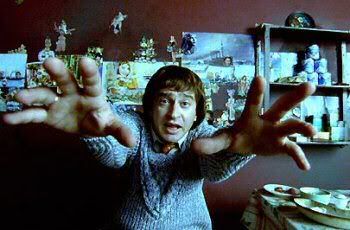
Anton first enters the Gloom
To his normal perceptions the witch appeared to be having a violent seizure. But an invisible force (a combatant in the Gloom level struggle), knocked Anton back, and he hit the wall behind him, at that instant passing into the Gloom. The Wall, which gains significance in the second film, is an interesting metaphorical device. Darya Schultz seems, for all intents and purposes, a traditionally operating, hex applying witch. This wall of her apartment features a collage of images clipped from magazines, advertisements intermixed with more supernatural details, like blue-skinned Hindu deities. This is an artful manner to indicate the practice of the occult through a modern, familiar context. Though it is not overtly expressed, this wall is the "rabbit hole" through which Anton enters the Gloom, and the allegorical reality of the Others.
This is unquestionably an initiatory scene, with many familiar emblems. The process began with intoxication, vodka laced with blood, a Dionysian detail. Dionysus was further invoked in the spectacular presentation of the shape shifter Tiger Cub, a Night Watch agent, whom Anton witnessed transforming into her tiger form and back again. The affiliation of a fierce maiden who turns into a Tiger is clear.
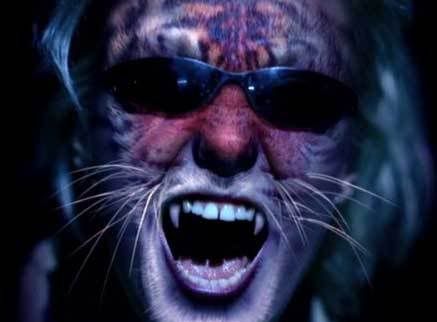
Tiger Cub is one of the movie's more prominent special effects. Another is "Little Masha", Schultz's familiar/homunculus, a rubber baby-doll that sprouts spider legs.
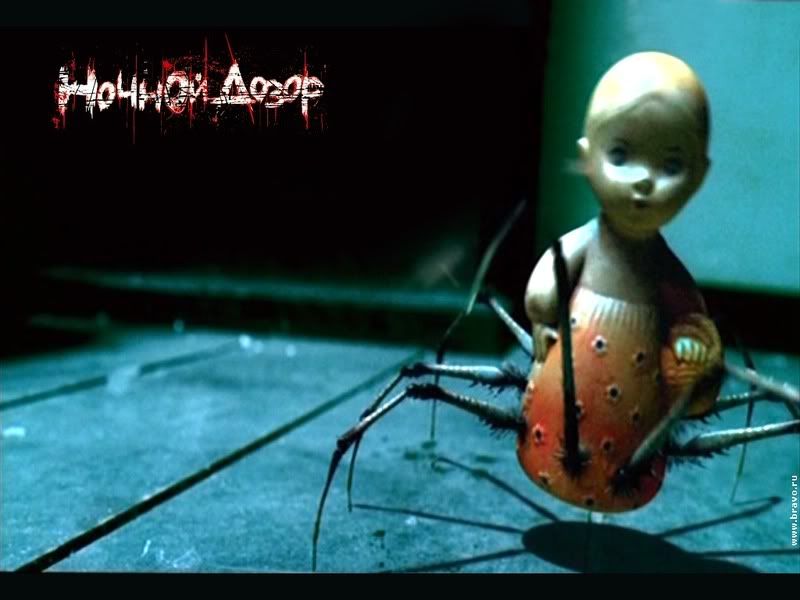
Little Masha
The Spider is another major initiatory emblem, connected to the labyrinth guiding goddess figure Ariadne, the bride of Dionysus. Interestingly, Fulcanelli refers to Ariadne multiple times in "the Mystery of the Cathedrals", more then once emphasizing the concept of the lifeless spider husk sitting at the center of the web. Little Masha neatly incorporates this aspect of the symbolism. "She" is quite effectively presented, as creepy in her way as Lovecraft's Brown Jenkins from "Dreams in the Witch-House".
The story jumps again, twelve years ahead, and now Anton has himself become an agent of the Night Watch. The Night Watch, punningly, pose as workers of the Light Company, patrolling in large, yellow utility trucks that are secretly souped-up with fantastic technology. If I'm reading the cultural correspondence correctly this would be the equivalent of the American white-utility van. The most prominent of these vehicles in the films features a gear shift handle with a pink rose encased in crystal.

In this dynamic shot we see the Night Watch engaged in a high-speed response to an emergency, accidentally crossing paths with Zavulon, the leader of the Dark Others. Zavulon demonstrates his great power by casually flipping the Night Watch vehicle over his head, returning it upright and unharmed. The proximity of the concentric hemispheres in the background architecture in this shot could be seen as suggesting the Night Watch agents being sent "over the Rainbow" by Zavulon (another Bridge metaphor). This scene is very similar to visual effects associated with Ian McKellen's Magneto in the X-Men films, and appropriately the figures play similar roles.
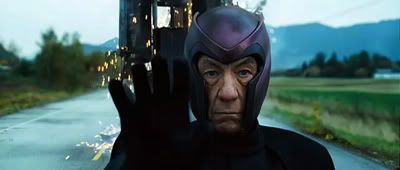
Anton is sent on a mission to intercept a human boy who is being summoned by the seductive "call" of a pair of Dark Other vampires. In order to attune his senses in the proper way for this job, Anton must drink blood himself, temporarily becoming something near to a vampire. He limits himself to pig's blood, which he acquires with the help of vampire neighbors, with whom he's on friendly terms despite being representatives of the opposite camps. Undead symbolism, particularly vampire stories, inherently include important "life after death/rebirth" initiation symbolism. The use of Pig's blood can be seen as suggestive of goddess affiliation. Freya, Ceridwen, Attis, Demeter, Atalanta, and Nut all carry associations with Pigs or Boars.
Another key symbolic item with clear initiatory/Mystery School significance is the weapon Anton equips himself with to face vampires, a flashlight (one that has several jewel-like bulbs, all presumably with different functions). A flashlight is of course a Torch.

Utilized as a weapon against vampires, the symbolic association between the Torch and the Sun is emphasized. J.E. Cirlot describes the Torch as representing "-purification through illumination". Besides its Promethean, Luciferian, and Eleusian connotations it is also worth noting that a Torch was the weapon used by Heracles to fight the Hydra.
Anton is directed by his superior to search the Moscow subway system, adding all important Underground and Train symbolism. On the subway Anton, described as a seer, has a vision seemingly unrelated to his vampire mission. Over the head of a sad looking young woman on the subway, Anton sees a black vortex, representing a powerful curse, interspersed with images of a cyclone of Crows, and of impending disasters, like a passenger plane crashing into the city.
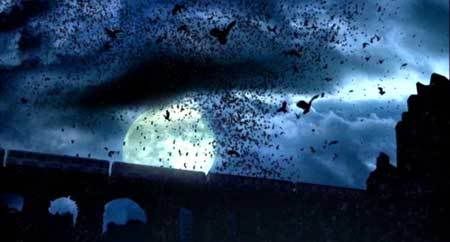
Both films make major use of the symbolism of Crows. First and foremost, as is the case with the Owl, we must recognize the essential symbolism of any Bird as indicative of the use of the Language of the Birds (the Green Language/Spoken Cabala). To Fulcanelli, the Crow is a prime symbol, calling it no less then the official seal of the Great Work of alchemy. In alchemical symbolism it represents the prima materia. The black coloration has led to associations with maternal night and fertile earth. It is an oracular animal and messenger agent. Cirlot states its atmospheric nature makes the Crow a "-symbol for creative, demiurgic power and for spiritual strength". The Crow is an attribute of Apollo. The Crow and the Raven carry the same symbolic meaning for all intents and purposes. Odin, the Norse Thoth/Mercury, observed the world with the help of his ravens Hugin and Munin, Thought and Memory. This is a notable association between Birds and a Wisdom figure, not unlike the relationship between Athena and the Owl.
Naturally, as a scavenger, it has an association with death. The Watch films feature enormous flocks or murders of crows, which has a different effect all together then the image of a solitary crow. This emphasizes the Crow's war symbolism. In the opening, medieval battle crows wheel about as the warriors battle below them. This is very much in line with the Crow symbolism associated with war goddess figures such as the complex, Irish Morrígan. This connotation is revealed to be fully appropriate.
The whirlwind/tornado/twister is a bit of an enigma as a symbolic device. We can intuit certain fundamentals regarding it due to it's inherent ties to Storm or Disaster symbolism, the basic form of the Spiral, and strong similarities to the Whirlpool. Overwhelmingly these various attributions come together to speak of the end of a World Age.
We are of course all well familiar with the use of a tornado as a portal between worlds from "The Wonderful Wizard of Oz" and its many antecedents. While it is not the case of the Baum novel, in the famous film Dorothy Gale's journey to Oz was a dream, making her experience of the tornado a literal symbolic experience, and her subsequent adventures in an "Other World" a perceptual experience due to an altered state of consciousness. And so this is not so different from the vision Anton experiences of the vortex, as a cyclone of Crows, above Svetlana's head. It is a vision/portent, literally a symbolic perception, that we might assume he experiences because as an Other his perceptions extend into the Other World of the Gloom/Twilight. And while I'm striving to avoid spoiling "Night Watch", there can be no doubt of the apocalyptic connotations of Anton's vision.
The relationship between various portals to Other Worlds, and a moment in time representing the End of the World, or the shift of a World Age is a huge complex deserving of much investigation. This pattern can be seen even in moments where it is not necessarily stated overtly. The House of Dorothy Gale journeys via violent tornado, and crushes the Wicked Witch of the East, an event of such consequence for the residents of Munchkinland that they immediately exalt Dorothy's accidental action with song. Dorothy's Oz adventures further alter the course of the Other World's history in major ways, removing the threat of the Wicked Witch of the West, exposing the Humbug Wizard who subsequently returns to his own world, establishing a temporary government under the Scarecrow (whom we can suppose fends off bad omen bearing Crows), until the return of the hermaphroditic Ozma, which marks the Dawning of a New Age, a sovereignty goddess returned to her proper position. Interestingly Cirlot, in discussing the symbolism of Spiders and Cobwebs, states, "-death and destruction lurk at the centre, so that the web with the spider in the middle comes to symbolize what Medusa the Gorgon represents when located in the centre of certain mosaics: the consuming whirlwind.".
Another fascinating observation by Cirlot states, "Going right back to the most ancient traditions, we find the distinction being made between the creative spiral (rising in a clockwise direction, and attributed to Pallas Athene)and the destructive spiral like a whirlwind (which twirls round to the left, and is an attribute of Poseidon)". Medusa was raped by Poseidon, and transformed into her monstrous form by Athena. The head of Medusa is an emblem of Athena featured on her Aegis. All of which is highly intriguing when associated with the character of Svetlana.
Anton's vision distracts him from his search, but he resumes, following the boy off the subway. Anton arrives just in time to stop the vampires from feeding off the boy, who is named Yegor. Anton is reluctant to enter the Gloom, and so fights opponents who are unseen. In an interesting play off the usual vampire convention, while in the Gloom they are only visible via reflected surfaces, emphasizing the Other World/Looking Glass connotation. The scene of Anton lurching about trying to fight an enemy through the reflection off a shard of mirror is not unlike how monsters with petrifying or otherwise deadly glares must be fought, like Gorgons (Medusa) and Basilisks.
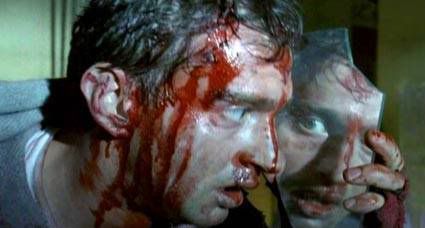
Fighting vampires "through the looking glass"
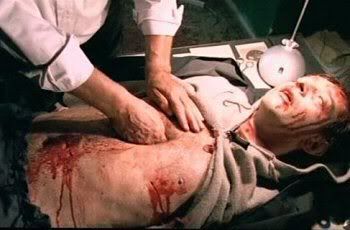
Anton is nearly killed in his fight with the vampires, and is rushed to the office of Gesser/Boris Ivanovich, the head of the Night Watch, who saves Anton by performing a psychic surgery, and then shares Anton's vision of the vortex through a method that includes taping shut Anton's left eye. This scene establishes the character and power of Gesser, a healer first and foremost, as opposed to the controlled but violent display by Dark Other leader Zavulon. Gesser determines the whirlwind/crow omen to be a catastrophic portent of highest immediacy. Gesser explains the whirlwind as a powerful curse, at a level spreading misfortune and disaster at an increasing rate and severity. A similar curse vortex is described as initiating the existence of the Others and the subsequent war between Light and Dark. In the Babylonian era a Virgin was given such a curse, which brought death and ruin to all around her, eventually generating the Dark Others. The Light Others arose to counter them and maintain necessary balance. It is strongly intimated that Svetlana is a reincarnation of the Virgin. Both curses then are clearly indicators of Age Shift.

Anton and Olga
To help Anton with both his mission to protect Yegor from the vampires and somehow halt Svetlana's vortex, Gesser assigns him a partner. Olga is a powerful Light Other witch who was punished for an indiscretion by being trapped in the form of a white owl, sometimes stuffed and sometimes animated. In the film she regains her human form shortly after she begins her partnership with Anton
As stated Owls carry all the connotations of the general symbolism of Birds, and like Crows represents wisdom. The Owl's nocturnal nature and ability to see in darkness are key aspects of its meanings. The nocturnal aspect, and its predatory nature, give rise to the Owl's ambiguity. Besides Athena, Owls are also associated with the Judaic night-demon Lilith and the Hindu goddess Durga (a figure also associated with Tigers). According to Cirlot, in Egyptian hieroglyphics the Owl indicates death, night, the cold and passivity, and the "realm of the dead sun", the sun when set below the horizon.
"Night Watch" brings the similar emblems of Crows and Owls into conjunction, the black of the Crows contrasted to the White of Olga the Owl. The interplay repeats on a small scale the larger scale dualistic symbolism of the story's plot line, the Light versus the Dark, a key dichotomy of the visual techniques of Baroque painting, the Chiaroscuro effect. This is the Yin Yang, a balanced dichotomy depicting a unity, a singularity in spiral motion. Our image of the Yin Yang is one of unity, but the same concepts may be expressed in a system where light and dark are placed in opposition. This is perhaps the most fundamental of all symbolic patterns, a metaphorical description capable of being expressed in a myriad of ways, but at its core always the most fundamental of mandalas.
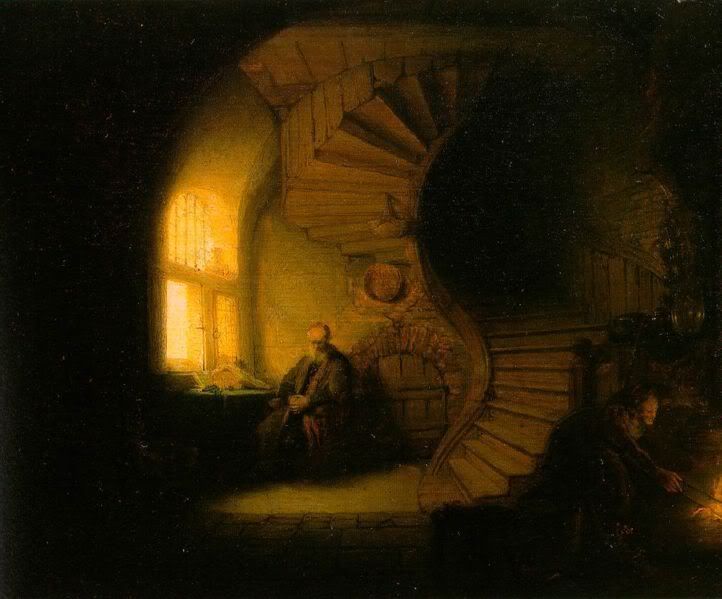
Rembrandt Harmenszoon van Rijn, "Philosopher in Meditation", 1632
No comments:
Post a Comment